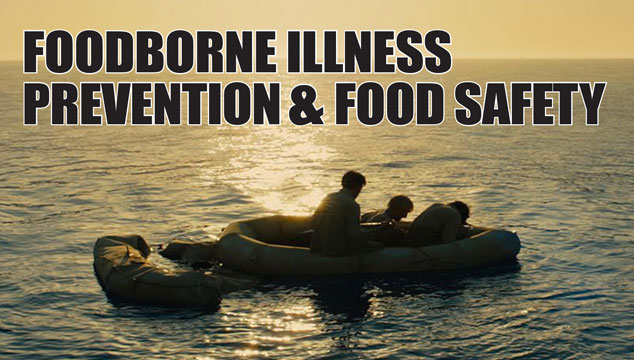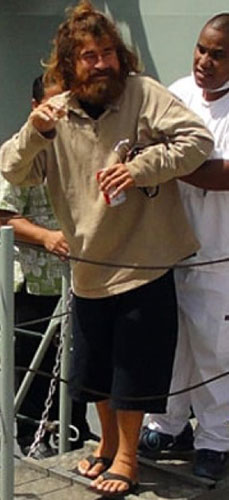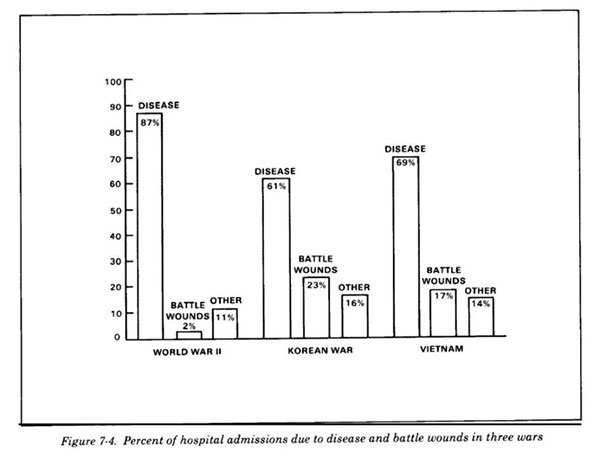
Disclaimer: The writer is a survival instructor and writer, not a medical doctor, so please consult with one before taking action. Do not mistake our survival advice for medical practice.
Bottom Line Up Front
- Don’t let unfamiliar food sources psyche you out.
- Far more would be survivors die because of microbes than bullets.
- Know the difference between venomous, poisonous, and potentially contaminated.
- Cook, pasteurize, or boil food to inactivate pathogens.
- Cure foods to inhibit bacterial growth.
- Preserve foods by cooking them, then drying them to decrease moisture content, and finally seal out air, light, and moisture.
- Store foods at a constant cold or cool temperature.
- Live food sources don’t spoil, so it is better to capture and not kill until you need it.
Adrift at Sea

What does being adrift at sea for 438 days have to do with foodborne illness and food safety?
When I think of foodborne illness and food safety,the name Jose Salvador Alvarenga jumps out in neon lights. Salvador survived 428 days adrift in the Pacific. Imagine yourself adrift at sea in a completely open boat with little more than a knife and a big ice chest that held your catch. How would you cook? What would you do for freshwater? What would you eat? How would you preserve food?
These questions lie at the heart of survival and knowing the answers could help you survive. I was fortunate to have the opportunity to study Salvador’s ordeal and to sit down with him to learn how to he survived. I will paraphrase legendary survival instructor, David Holladay’s observation as we discussed Salvador’s ordeal, “Human beings are problem solvers. Everything we need to survive is already in us. It may be dormant, but it is there”.
Many beginning survivalists focus on the threat of deadly force even though there is something far more likely to kill them than bullets. The preoccupation with firearms is only natural as getting shot is a traumatic threat which means we tend to remember it. Research indicates that more than 70% of survivalists are new to survival. Most are first exposed to survival through TV shows and movies. Most of these shows and movies are graphically violent which causes this threat to stick out in the mind.
The truth is that we are far more likely to be killed by microbes than bullets. This graph of hospital admissions of US soldiers during three major wars illustrates this point very effectively.

Even for soldiers during war time, an amount several times greater are admitted to hospitals due to disease than battle wounds.
Which war do think most closely resembled survival conditions? In my opinion, it was WWII. Technology was just began to take over. In catastrophes where infrastructure goes down, we might even have to look at wars further back in history to better simulate the circumstances. Without the grid, we would eventually see a resurgence of diseases long eradicated in most highly-developed nations. Only this time around, we would be highly vulnerable to these diseases since entire generations have no developed antibodies to fight them.
Food Identification
I do not have the space to delve too far into plant and animal identification in an article, but I will list a few key points.
Venomous vs Poisonous vs Potentially Contaminated:
Córdoba, who was Salvador’s crewman and friend, didn’t understand the difference between venomous and poisonous. This may have been what killed him.
Venomous – Many venomous vertebrates, like snakes, are safe to eat if you remove the head which contains the venom glands. Some venoms are not lethal when swallowed as long as your digestive tract does not have any tears or ulcers. The fact that special forces soldiers are sometimes referred to as “snake eaters” is a testament to this truth. In Córdoba’s case, he was eating a raw seabird and discovered that it had a partially-digested poisonous sea snake in the belly. He immediately reacted violently and refused to eat any more seabirds.
They were to become the primary food source that enabled Salvador to survive. Upon discovery of the snake, Córdoba became convinced that he would die, and die he did. Remember that physiology rapidly follows psychology. Alan Kay, who won the first season of the TV Series Alone!, described survival psychology thus, “Survival is 90% mental … from the neck up”.
Poisonous – Inherently poisonous creatures or plants are typically best left off the menu, especially if you have other choices. An example would be the pufferfish which contains tetrodotoxin.
Potentially Contaminated – If a turtle eats poisonous mushrooms or algae then you eat the turtle, it can make you sick or die. This doesn’t mean all turtles are poisonous, it means that turtles can eat things that we can’t. If they do and we eat their flesh, we may in turn be poisoned. Many species of fish in the West Indies, Pacific and Indian Oceans are often contaminated with the marine toxins that cause the foodborne illness known as ciguatera fish poisoning. Such as some very abundant species of triggerfish which are often first to arrive at boats and liferafts.
Other species of tropical fish that are commonly contaminated with ciguatera are: barracuda, red snapper, amberjack, mackerel, surgeonfish, and parrotfish. If a fish is contaminated then you eat its flesh, you will become extremely ill and may die. In terms of austere treatment, all you can do is manage any symptoms and complications. Eating these species must be a judgement call. Many of the most popular survival manuals categorically forbid you from eating them. This may be that most survival manuals contain a lot of regurgitated military manuals, liability concerns, or some combination thereof.
If Salvador had read one of these manuals and followed the advice, I never would have been able to learn from him, because he would have died from starvation. If you make the call and eat contaminated fish, you’ll know within a few minutes to 6 hours. So protocol is to take a tiny nibble and wait half a day. No diarrhea, vomiting, nausea, headache, numbness, or tingling? Double your nibble and wait again.
Look-alikes – Research which species have dangerous look-alikes and learn to differentiate.
Edibility Test – Learn the edibility test for emergency use when you’re less than certain about an item. Do not use the edibility test for species known to have dangerously poisonous look-alikes.
Plant ID – Learn to identify plants that grow everywhere you go, what resources are available in each season, and how to make them edible. Some take more work than others, but many of the most important foods we eat cannot be simply plucked off the vine and eaten the way we’re familiar with. Gathering wild edibles is the mainstay of hunter-gatherer populations, not hunting.
Fungi ID – Learning to confidently identify fungi has a huge payoff but is no place for short cuts. Do not use the edibility test with fungi. If you’re unsure of classification, do not eat them as many species are highly poisonous and many look-alikes exist.
Animal ID – Birds, fish, shellfish, bivalves, mammals, reptiles, arthropods, and so on, each have rules. Learn to identify and prepare the primary edible species in your area.
General Tips for Assessing Fitness in Animals – Assess overall health. Eat healthy animals that were alive when you found them, you know the cause of death, or it’s apparent.
- Examine the Eyes – Cloudy, glazed, bloodshot, or yellowed eyes can be signs of infection, poison, or excessive aging. If you are unsure if an animal is dead or alive, touching the eye lightly with a long twig is a way to check as animals cannot control their blink reflex.
- Examine the Skin – An abundance of ticks or parasites, mange can be signs that the animal is not taking care of itself which can be a sign of illness.
- Examine the Flesh and Organs – Spots on the meat, discoloration, presence of pus or abnormal growths are signs that all is not well with your would-be meal.
- What Does It Eat? – Herbivorous animals are typically preferable to omnivores and omnivores to carnivores
Food Preparation and Preservation
Once an organism dies, decay begins. Food preservation is about delaying the process of decay.
Deactivate Pathogens – Cooking, boiling, and pasteurizing are all examples of deactivating pathogens.This stops the pathogens from further reproduction. The pressure cooker is the best tool to do this for most folks. Salvador didn’t have a way to cook adrift at sea. He deactivated pathogens by cutting fish, birds, and turtles into very thin slices and sun drying them on the cover of his outboard motor.
Avoid
- Room temperature foods.
- Undercooked or raw eggs, meat, dairy products.
- Unsealed or opened packages.
- Bulging cans.
- Food from street vendors.
- Condiments with fresh ingredients.
- Water from drinking fountains, taps, untested wells/ ice, drinks or juices made with water from these sources.
Do Eat/Drink
- Prepare your own food.
- Well cooked food served hot.
- Food in sealed packages
- Food you properly prepared yourself.
- Pasteurized dairy products.
- Bottled or canned drinks.
Inhibit Growth of Pathogens – Bacteria, fungi, mold, and other pathogens need certain things to live. Taking these away will limit their reproduction and cause survival rates to drop precipitously. A notable example of this is pemmican prepared by boiling, sealed in buffalo skins, packed with tallow, tied off, and then sun dried. Growth can be discouraged with growth-inhibiting treatment processes such as salting, pickling, or sugar curing.
Take away the following to inhibit unwanted growth:
- Sunlight – As it hardened, the buffalo skin acted like amber glass which blocks out sunlight.
- Oxygen – Vacuum packed foods and those packed with oxygen absorbers last longer. The process of sun drying caused the buffalo skins to shrink and harden, much like the vacuum pack process. Tallow created air-tight plugs. Sausage is another technique that deprives food of oxygen.
- Moisture – Freeze drying can result in many foods lasting 30 years or more. In our pemmican, sun drying decreased moisture. Ever tried to store a wet MRE entrée in a vehicle over the summer? Wet MRE entrees won’t last a summer in Arizona. Extremely low moisture content is the key to storing food in vehicles long term. In this environment, extremely low moisture lifeboat type ration bars or GP Survival Rations store best. Examples of technology are smokers and drying racks.
- Warmth – How many times have you heard to “Store in a cool, dry place”? A constant storage temperature is also important. Primitive examples for cooling food are root cellars or digging caches to store food. Also you can create evaporative coolers using water to wet ceramics or thin, gauzy cloth such as cheesecloth. This allows air to move through them.
Keep Food Alive Until Needed – A simple example is keeping fish fresh by using a stringer. Salvador faced a serious dilemma on his boat. He set up a pole as a roost and lay perfectly still as birds would land until they felt safe, began preening, and got distracted. Then he grabbed them and snapped their necks so they would stop fighting him. But how could he preserve poultry at sea without power or ice?
He would see a couple of birds passing near islands and then go days or weeks without catching one. Salvador solved this problem by snapping a wing so they couldn’t fly away. Pretty soon he had a flock of live birds in the bow of his little fishing boat. When he drifted past a whale where carcass birds were landing, Salvador increased his floating stockyard to its peak of some 30 birds.
Mr. Alvarenga also kept immature sea turtles alive. Also, he saved turtle and bird eggs found inside them to eat later. He drank bird and turtle blood to stave off dehydration. Fortunately for him this blood contained enough vitamin C to keep scurvy at bay for well over a year adrift at sea.
